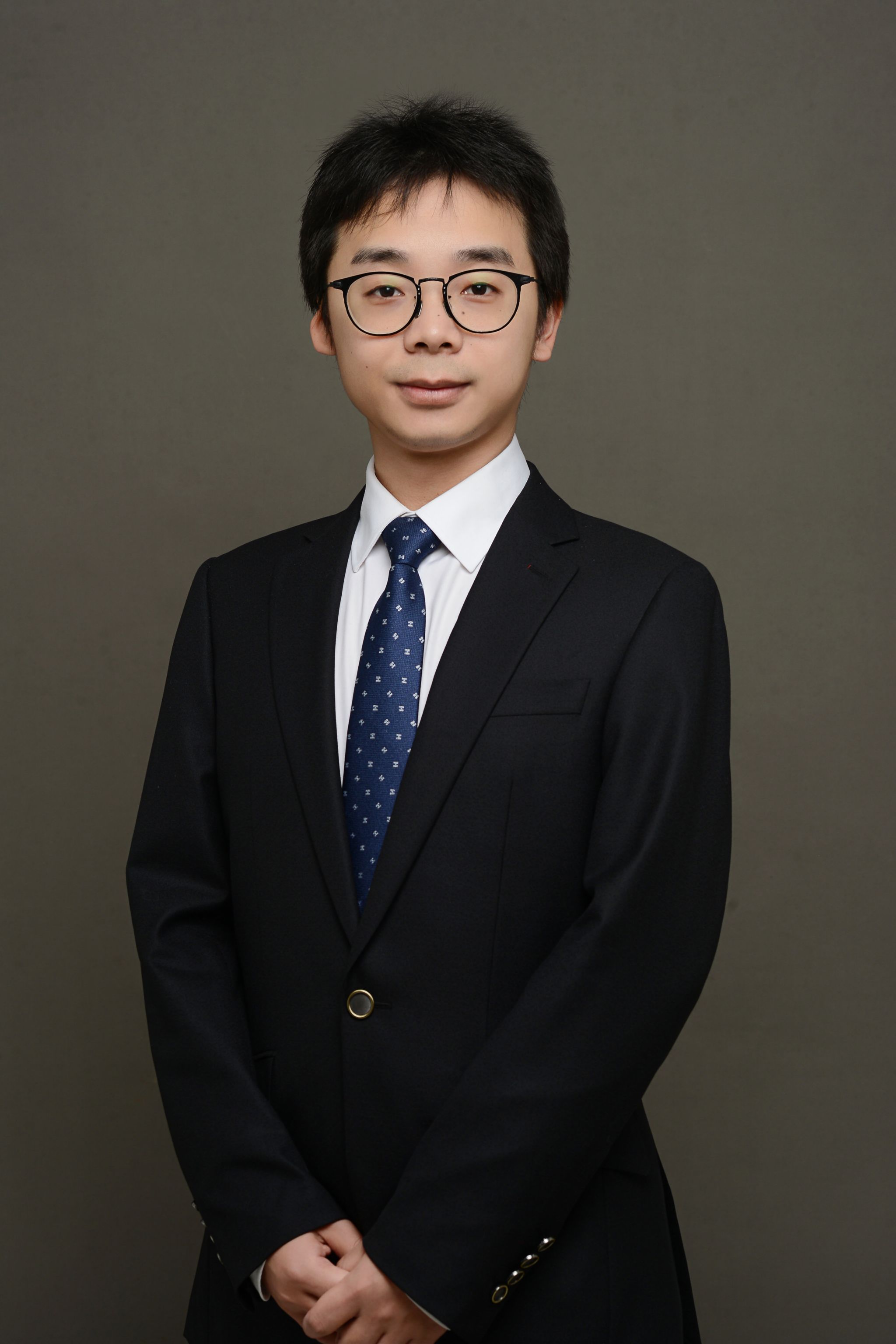
张博凯,贵阳人,中共党员,副教授,硕士生导师。2011年毕业于贵州大学物理学专业,2016年获南京大学理论物理学博士学位(导师:马余强 院士、陈康 教授),之后在北京计算科学研究中心从事博士后研究(合作导师:徐辛亮 研究员),曾在浙江理工大学物理系任教,2022年3月至今,任西南大学物理科学与技术学院副教授。本人长期从事软物质与生物物理研究,以第一或通讯作者在PNAS,Sci. Adv., J. Fluid Mech., Macromolecules, Soft Matter, J. Chem. Phys. 等期刊上发表论文10余篇论文。已主持国家自然科学基金3项,入选重庆市“巴渝学者”青年学者,是中国物理学会会员、中国化学学会会员、担任物理学或流体力学期刊Physical Review Letters/ Research/ E、Phys. Fluids独立审稿人。
I am interested in soft condensed matter physics, polymer physics, active matter, and bacterial hydrodynamics. My current research mainly focuses on the theoretical and computational aspects of the following topics: (1) Conformation, topology, and dynamics of biopolymers. (2) Low-Reynolds hydrodynamics and active fluids. (3) Glass transition and slow dynamics in polymer nanocomposites.
Main research methods
(i) Molecular/Brownian dynamics simulations
(ii) The Method of Regularized Stokeslets
(iii) Simulation and theory of bacterial suspension
(iv) The nonlinear Langevin equation theory and Polymer Polymer Reference Interaction Site Model (PRISM) theory
张博凯长期从事活性凝聚态物理(细菌、微藻、微丝和微纳米机器人)的理论与计算机模拟研究,此领域是物理学与力学、生命科学、生态学、医学等多学科交叉融合的前沿领域,涉及到了微生物感染、生殖细胞结合、药物输运、排污控制、海洋碳循环等与生命健康和国家战略息息相关的生物学和生态学问题;本人兴趣主要集中在:
(1) 浮游微生物个体游动和集体行为
(2) 生物高分子的构型、拓扑和动力学研究
(3) 高分子纳米复合物、胶体以及颗粒体系的玻璃化转变
课题组计划每年招收硕士研究生1-2名,欢迎有兴趣从事高分子物理、生物流体力学、玻璃化转变等软物质物理学中的理论与计算机模拟研究的同学与我联系,也欢迎本科学生来课题组进行科研实习,联系方式:bkaizhang(AT)sina.cn, zbk329(AT)swu.edu.cn
研究组(group):
袁崇博、郭永梅、张佳佳、李亚鹏、曾源源(2022级本科生,已保研南开大学)
已毕业学生(alumni):
1. 李靖(2022级硕士,与汪志勇教授联合培养),目前在华南理工大学读博
2. 李洪尧(2022级硕士,与汪志勇教授联合培养),目前在苏州大学读博
3. 胡明毅(2023级硕士,与汪志勇教授联合培养),中学物理教师
4. 吴友鹏(2020级本科),目前在北京大学硕博连读
5. 张宇飞 (2021级本科),目前在北京理工大学硕博连读
主要担任课程(courses):
《量子力学》(国家一流课程,本科生)
《高等数学》(本科生)
《科技英语》(本科生)
近期主持科研项目(projects):
(1) 中央高校基本科研能力提升项目,2025-2027
(2) 国家自然科学基金面上项目,2024-2027
(3) 中央高校基本科研业务费项目,2023-2024
(4) 国家自然科学基金青年科学基金项目,2020-2022
(5) 国家自然科学基金应急管理项目(理论物理专款),2019
任现职以来的代表性工作:
1.使用斯托克斯点力法和低雷诺数流体理论,通过近场流体力学相互作用解释了实验上油滴转子在细菌溶液中的加速转动,并指出近场作用在细菌湍流的间歇性涡旋中扮演重要作用。
H. X. Huang+, B. K. Zhang+, S. Guo*, “Crowding accelerates the rotation of a bacterial rotor”, J. Fluid Mech., 994, A12 (2024).
2. 通过分子动力学模拟,提出了聚合物链的活性修饰策略,发现活性诱导了聚合物的刚性,进而导致了缠结的网络和反常的慢动力学特性,该工作为相关的活性聚合物材料设计提供了新的思路。
J. Li, B. K. Zhang*, Z. -Y. Wang*, “Activity-induced stiffness, entanglement network and dynamic slowdown in unentangled semidilute polymer solutions”, Soft Matter 20, 5174-5182 (2024).
3.机械键诱导的玻璃化转变是一个重要的拓扑玻璃的例子,该研究揭示了该拓扑玻璃化转变的机制:机械键导致的永久缠结在环形聚合物单体中产生了有效的刚性,从而抑制了质心和单体的动力学。该工作为设计各种拓扑结构的聚合物玻璃提供了启发。
J. Li, B. K. Zhang*, and Y.-S. Li*, “Glass formation in mechanically interlocked ring polymers: the role of induced chain stiffness”, Macromolecules 56, 2, 589–600 (2023)
主要学术报告(presentations)
1. 四川省物理年会,2025年4月,成都,口头报告
2. 复杂系统理论物理中心启动会,2024年11月,南京,口头报告
3. 中国物理学会秋季学术会议,2024年10月,海口,口头报告
4. 复杂系统前沿科学研讨会,2024年9月,南京,口头报告
5. 浙江软物质与复杂系统学术研讨会,2024年4月,杭州,口头报告
6. 活性物质物理前沿研讨会,2023年8月,南京,口头报告
7. 江苏物理春季学术会议,2023年5月,南京,口头报告
8. 中国化学会软物质理论计算与模拟学术会议,2023年4月,长春,口头报告
9. 全国统计物理与复杂系统学术会议暨海峡两岸统计物理会议,2021年8月,长春,口头报告
10. APS流体力学年会, 2017年11月, 丹佛, 口头报告
论文发表清单(publications)
24. Spontaneous phase transition in bacterial polar fluids
H Tan, B K Zhang*, S Guo*
(submitted), https://doi.org/10.21203/rs.3.rs-7760051/v1
23. Bacterial turbulence at compressible fluid interfaces
Y Yin, B K Zhang*, H P Zhang, S Guo*
(submitted), arXiv: 2511.12612
23. Molecular chaos in dense active systems
L Chen, KJ Welch, P Leishangthem, D Ghosh, B K Zhang, T.-P Sun, J Klukas, Z. C. Tu, X Cheng, X.-L Xu, “Molecular chaos in dense active systems”, arXiv:2302.10525.
2025
22. Chain ends excite polymer cooperative motion
Q Xu, Z Wu, K Randazzo, W-S Xu, B K Zhang*, R D Priestley*, B Zuo*
Sci. Adv., in press (2025) 理论部分通讯
2024
21. Crowding accelerates the rotation of a bacterial rotor
H X Huang#, B K Zhang#, S Guo*
J. Fluid Mech. 994, A12 (2024) 共一作
20. Activity-induced stiffness, entanglement network and dynamic slowdown in unentangled semidilute polymer solutions
J Li, B K Zhang*, Z-Y Wang*
Soft Matter 20, 5174–5182 (2024)
19. Conformational and static properties of tagged chains in solvents: effect of chain connectivity in solvent molecules
H Y Li, B K Zhang*, Z-Y Wang*
Soft Matter 20, 3073 (2024)
2023
18. Initial-state dependence of phase behaviors in a dense active system
L Chen*, B K Zhang, Z C Tu
Chin. Phys. B 32, 086401 (2023)
17. Glass formation in mechanically interlocked ring polymers: the role of induced chain stiffness
J Li, B K Zhang*, Y-S Li*
Macromolecules 56, 2, 589–600 (2023)
2022
16. Intrinsic spin, valley and piezoelectric polarizations in room-temperature ferrovalley Janus TiXY (XY = SCl and SeBr) monolayers
K Sheng, H-K Yuan, B K Zhang*
Nanoscale 14, 15156–15164 (2022)
15. Strain-engineered topological phase transitions in ferrovalley 2H-RuCl₂ monolayer
K Sheng, B K Zhang, H-K Yuan, Z-Y Wang*
Phys. Rev. B 105, 195312 (2022)
14. Dissecting the co-segregation probability from genome architecture mapping
L Liu*, X-M Cao, B K Zhang, C Hyeon*
Biophys. J. 121, 20 (2022)
Before 2021
13. An effective and efficient model of the near field hydrodynamic interactions for active suspensions of bacteria
B K Zhang, P Leishangthem, Y Ding*, X-L Xu*
Proc. Natl. Acad. Sci. USA 118, e2100145118 (2021)
12. Theory of polymer diffusion in polymer–nanoparticle mixtures: effect of nanoparticle concentration and polymer length
B K Zhang*, J Li, J-M Hu, L Liu*
Soft Matter 17, 4632 (2021)
11. Microscopic theory for elastic modulus of colloidal polymers: effect of bond length
B K Zhang*
Acta Physica Sinica 70, 12, 126401 (2021)
10. Glassy dynamics of model colloidal polymers: Effect of controlled chain stiffness
J Li, B K Zhang*, Y-S Li*
Chin. Phys. B 30, 3, 036104 (2021)
9. Extracting multi-way chromatin contacts from Hi-C data
L Liu*, B K Zhang, C Hyeon*
PLoS Comput. Biol. 17(12): e1009669 (2021)
8. Effect of chain length on structure and dynamics in a melt of semiflexible rings
J Li*, B K Zhang*
EPL 130, 56001 (2020)
7. Metabasin dynamics of supercooled polymer melt
J Li*, B K Zhang
Chin. Phys. B 28, 12, 126101 (2019)
6. Unique role of bond length in the glassy dynamics of colloidal polymers
B K Zhang, H-S Li, J Li, K Chen*, W-D Tian*, Y-Q Ma*
Soft Matter 12, 8104 (2016)
5. Transport coefficients and mechanical response in hard-disk colloidal suspensions
B K Zhang*, J Li, K Chen, W-D Tian, Y-Q Ma
Chin. Phys. B 25, 116101 (2016)
4. A new self-consistent field model of polymer/nanoparticle mixture
K Chen*, H-S Li, B K Zhang, J Li, W-D Tian*
Scientific Reports 6, 20355 (2016)
3. Glassy dynamics of model colloidal polymers: the effect of “monomer” size
J Li, B K Zhang, H-S Li, K Chen*, W-D Tian*, P-Q Tong*
J. Chem. Phys. 144, 204509 (2016)
2. Brush in the bath of active particles: anomalous stretching of chains and distribution of particles
H-S Li, B K Zhang, J Li, W-D Tian*, K Chen
J. Chem. Phys. 143, 224903 (2015)
1. Theory of activated dynamics and glass transition of hard colloids in two dimensions
B K Zhang, H-S Li, W-D Tian, K Chen*, Y-Q Ma*
J. Chem. Phys. 140, 094506 (2014)
——Updated Nov. 2025